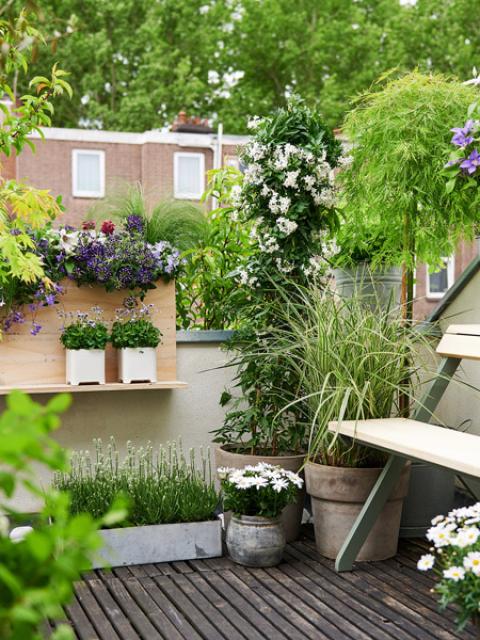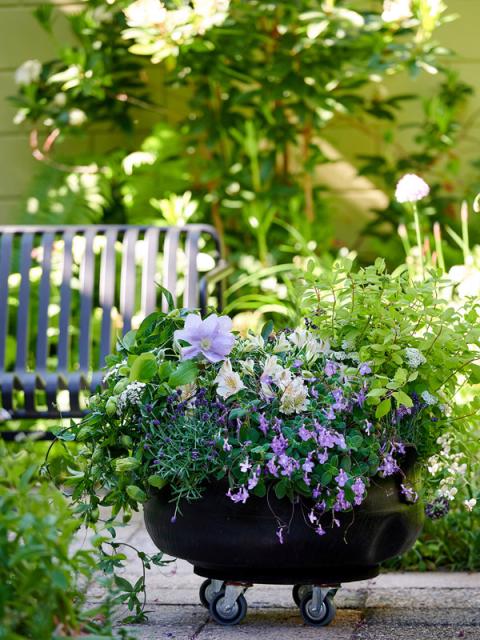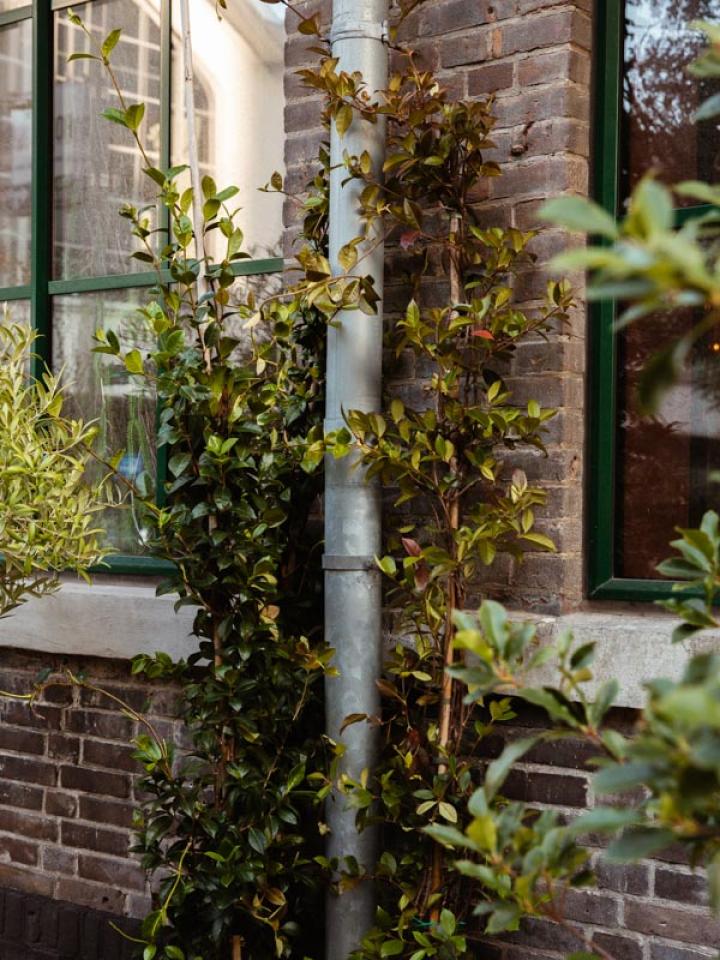
1) TUSCAN JASMINE
Tuscan jasmine is a beautiful climber with dark green leaves and fragrant white flowers which usually bloom in May and June. The plant winds its way around everything, and easily turns your wall into a graceful green work of art. A piece of gauze or trellis provides enough support for the Tuscan jasmine. The plant is less suitable for growing pergolas. In the summer, twist or tie the support-seeking branches into the mesh or trellis.
TUSCAN JASMINE: WHERE TO PLANT IT AND CARE TIPS
Looking to plant Tuscan jasmine against a wall, fence or other structure? Here's what you need to know about the planting location and care of Tuscan jasmine:
- Tuscan jasmine thrives best in a sunny or semi-shaded spot. The climbing plant needs four-six hours of direct sunlight a day for optimal growth and flowering.
- Tuscan jasmine grows best in well-drained soil that retains moisture but is not soggy.
- Water Tuscan jasmine regularly during dry, hot periods, but avoid soaking the soil.
- If necessary, apply a layer of mulch (organic material such as compost) around the climber to retain moisture and suppress weed growth.
PRUNING TUSCAN JASMINE
For optimal growth and flowering, it's important to prune Tuscan jasmine. Check out the tips below:
- Prune Tuscan jasmine immediately after flowering (in late spring or early summer).
- Remove dead, diseased or damaged branches by cutting them all the way back to the base of the plant.
- Cut back long, protruding shoots to keep the plant more compact and bushy.
- If you want the plant to follow a certain shape, such as along a trellis or fence, you can guide and cut the shoots to achieve the desired shape.
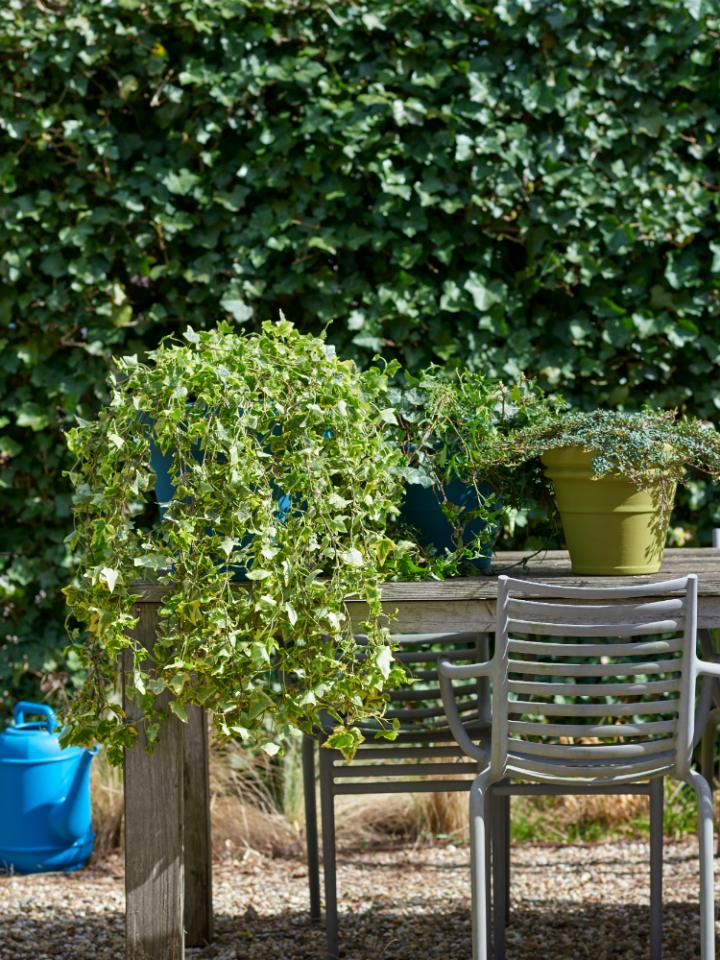
2) IVY
Ivy, also known as Hedera Helix, easily climbs against walls with its grippy roots. It can climb to 25-30 metres high! This evergreen is easy to manage and requires little maintenance. It doesn't flower as a young plant, but an adult produces yellow-green flowers from which black berries emerge.
IVY: where to plant it and care tips
Ivy is an easy-to-care-for climbing plant. Want to plant ivy against a wall, fence or other structure? Then consider the best planting location and care tips for ivy:
- Ivy thrives almost anywhere, in both sun and shade. The climber prefers a location with partial shade, especially in warmer climates.
- Ivy thrives in different types of soil, but prefers moist, well-drained soil.
- Make sure the soil does not get too wet. Too much water can lead to root rot.
- Water ivy regularly during dry, hot periods.
- If necessary, apply a layer of mulch (organic material such as compost) to help the plant retain moisture and suppress weed growth.
pruning ivy
Pruning ivy isn't a necessity, but it can be helpful in limiting growth and keeping the plant healthy. Check out the tips below for pruning ivy:
- In principle, ivy can be pruned all year round, as long as it does not freeze. Spring (April/May) and autumn (September) are the best seasons to give it a haircut, because if you prune when there is a chance of frost ivy can be damaged.
- If necessary, prune back protruding or unwanted branches to just above a leaf node.
- Remove dead or damaged leaves regularly.
- If you want to prevent ivy from overgrowing or expanding, you can prune back the growing ends to make the plant more compact.
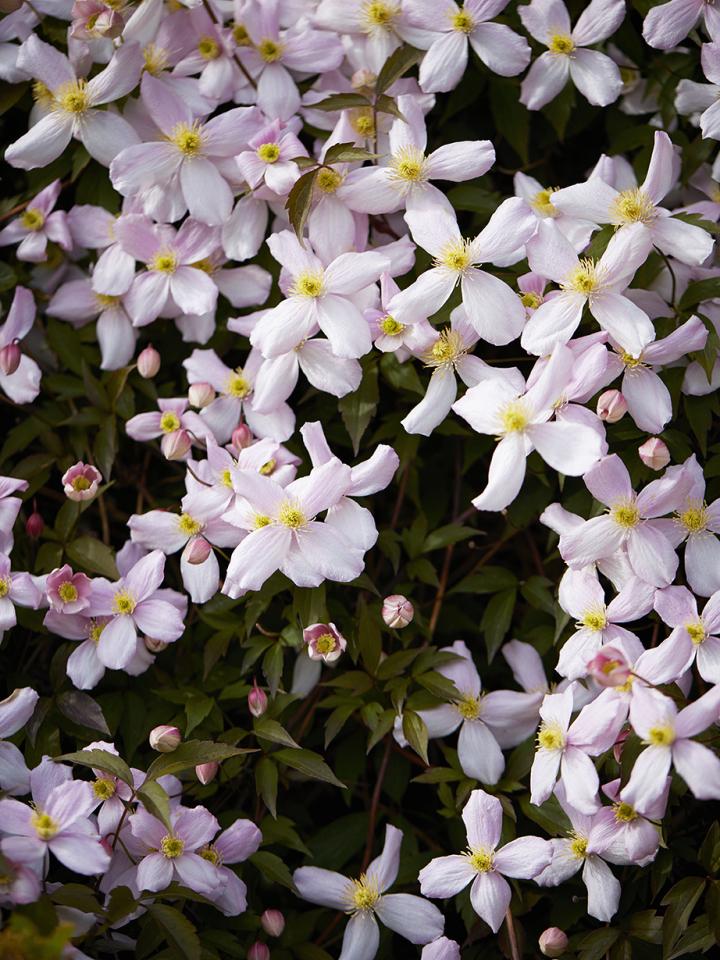
3) clematis
Clematis is a popular climbing plant that is easy to maintain and just as easy to wrap itself around your heart. The climber is green in the winter months and produces abundant flowers in frost-free months. There's lots of choice for colourful flowers, from soft pink to lilac, purple and blue! The flowers are available in different shapes, from simple (four petals with a yellow heart) to more striking specimens (different colours with fringes in the middle).
clematis: where to plant it and care tips
There are hundreds of varieties of Clematis, including as a perennial and as a climbing plant. Think carefully about which type of Clematis you prefer and the care that it will need. Do you want to plant a climbing Clematis against an outside wall, fence or other structure? Then take a look at the care tips below:
- Clematis grows best in rich, fertile soil that is permeable to water and not too dry. Clematis prefers to have its 'head' in the sun and its 'feet' in the shade. Therefore, give the climbing plant a cool base (such as by planting it with a perennial or ground cover).
- Clematis thrives best in a spot in the sun or semi-shade. A sunny south-facing wall is not suitable, as Clematis cannot stand dry heat. Nor should there be too much shade, because then the climbing plant will form fewer flowers.
- Suffering from a dry, hot period in the summer? Then water Clematis in the early morning or late in the evening.
pruning clematis
Pruning Clematis is necessary to ensure healthy growth and flowering. Pruning also ensures that the plant doesn't grow too big. If you prune the climbing plant at the wrong time, it won't bloom. There are different types of Clematis, each of which should be pruned at a different time depending on their flowering period.
- Spring-flowering Clematis (flowering between March-May): immediately after flowering, prune away only the dead and weak branches of the plant. Cut away the lower, old branches of the woodland vine every few years. A spring-flowering Clematis produces flowers on last year's wood, so if you prune it before flowering, you run the risk of removing flower buds.
- Summer-flowering Clematis (flowering around May-June): summer-flowering Clematis are usually pruned in early spring, before the climbing plant sprouts (i.e. before it starts growing). Remove dead, weak or damaged branches and prune back remaining branches to just above a bud. Prune back to about 30-50 centimetres above the ground, depending on the species and desired size.
- Late-flowering Clematis (flowering between July-September): Clematis that flowers later in summer may be pruned more thoroughly in spring. You can cut branches down to just above a bud. Cut down to a second or third pair of buds above the ground (about 30-50 centimetres).

4) passionflower
Passionflower, also known as passiflora, immediately gives your wall an exotic look. There are more than 500 varieties of this climbing plant. It's easy to maintain and you can go in all directions in terms of colour, from blue to red, orange, yellow and white. In summer, some varieties also produce decorative fruits.
passionflower: where to plant it and care tips
Are you going for passionflower as an outdoor wall-climbing plant? Then keep in mind the right planting location and care needed. Check out the tips below:
- Passionflower thrives best in a sunny position, where the climbing plant gets at least six hours of direct sunlight a day.
- Provide well-drained soil that retains moisture but does not get too soggy.
- Passionflower likes to be somewhat sheltered. Protect passionflower from strong winds, especially in colder climates, to prevent damage to its fragile stems.
- Water passionflower regularly during dry, hot periods.
- If necessary, apply a layer of mulch (organic material such as compost) around the plant to help it retain moisture and suppress weed growth.
pruning passionflower
Maintaining passionflower is very simple. This climbing plant requires little maintenance, but it can still make sense to prune it:
- Prune back unwanted or protruding branches of passionflower to just above a flower bud.
- Remove dead, diseased or damaged branches of passionflower by pruning them all the way back to the base of the climber.
- If the passionflower gets too big or sticks out too far, you can prune back the ends to make it more compact.
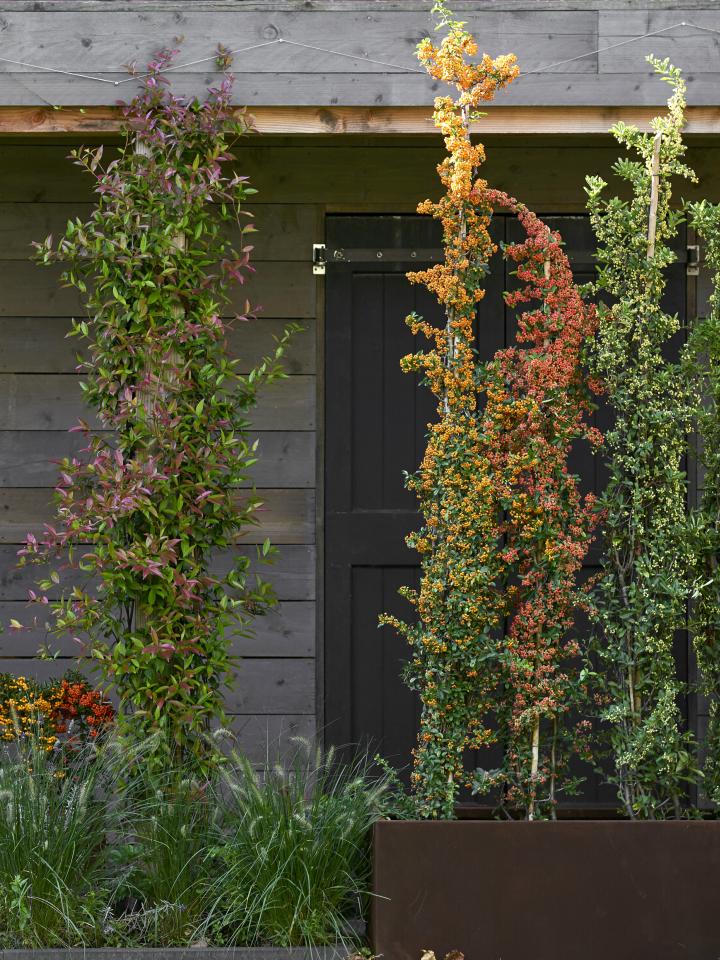
5) pyracanthia
Pyracantha, also called firethorn, has a striking appearance. The climber has dark green leaves and can grow up to three metres high. Pyracantha blooms profusely in May or June and develops small white flowers. In late summer, the flowers - thanks to the bees - make way for red, orange or yellow berries. It is wise to keep this plant trimmed every year, so that it continues to grow nice and flat against the wall.
pyracanthia: where to plant it and care tips
Do you choose Pyracantha to grow against your wall, trellis or fence? You'll want to enjoy its beautiful blooms to the full. Check out the following tips on planting location and how to take care of firethorn:
- Pyracantha thrives best in a sunny location, but also does well in a semi-shaded spot.
- Pyracantha is an easy climbing plant that grows well in almost any permeable soil that does not get too soggy.
- Some varieties can grow quite large, so choose (depending on the species) a location with enough room to grow.
- Water firethorn regularly during dry, hot periods.
- If necessary, apply a layer of mulch (organic material such as compost) around the plant to help retain moisture and suppress weed growth.
pruning pyracanthia
When a firethorn grows freely, pruning is hardly necessary. But if you want this climbing plant to grow and lie nicely flat against your wall, it's wise to prune it every year. Check out the tips for pruning Pyracantha below:
- Prune Pyracantha after the climber has finished flowering (in summer). Prune away the unwanted branches. You can leave spent flowers in place so that berries can form in late summer.
- Remove dead, diseased or damaged branches of the firethorn by pruning them all the way back to the base of the plant.
- Cut back long, protruding shoots to a healthy, strong bud to make the plant more compact.

6) honeysuckle
Honeysuckle doesn't just look as though it belongs in a fairytale, it smells that way too! This lush 'plant of love' has beautiful, sweet flowers that have an extra soft and sugary fragrance at night. The flowers are mostly pink and yellow-white, but also come in other shades. After flowering, red, blue or black berries appear. Honeysuckle climbs easily and, depending on the species, can reach a height of up to four metres.
honeysuckle: where to plant it and care tips
Looking into Honeysuckle as an outdoor wall-climbing plant? Check out the tips below for the best planting location and caretaking tips for this fragrant climbing plant:
- Honeysuckle thrives best in a spot in sun or semi-shade. The plant can grow in a shady spot, but will then flower less profusely.
- Honeysuckle grows well in various types of soil, provided the soil is well-drained and not too soggy.
- Honeysuckle can grow quite large and tall, so if that's your wish give this climbing plant plenty of space.
- Water honeysuckle regularly during dry, warm periods.
- If necessary, apply a layer of mulch (organic material such as compost) around the plant to better retain moisture and suppress weed growth.
honeysuckle pruning
Pruning honeysuckle isn't strictly necessary, but pruning climbing honeysuckle will promote growth and flowering and help you maintain a nice shape as it grows. Check out the tips below for pruning climbing honeysuckle:
- Prune climbing honeysuckle preferably once a year, in spring (March/April).
- Cut away about 10 centimetres from the main branches and shorten branches that are too long.
- Remove dead, diseased or damaged branches by pruning them back to the base of the plant.
- A naturalised honeysuckle can be cut back to 50 centimetres above the ground.
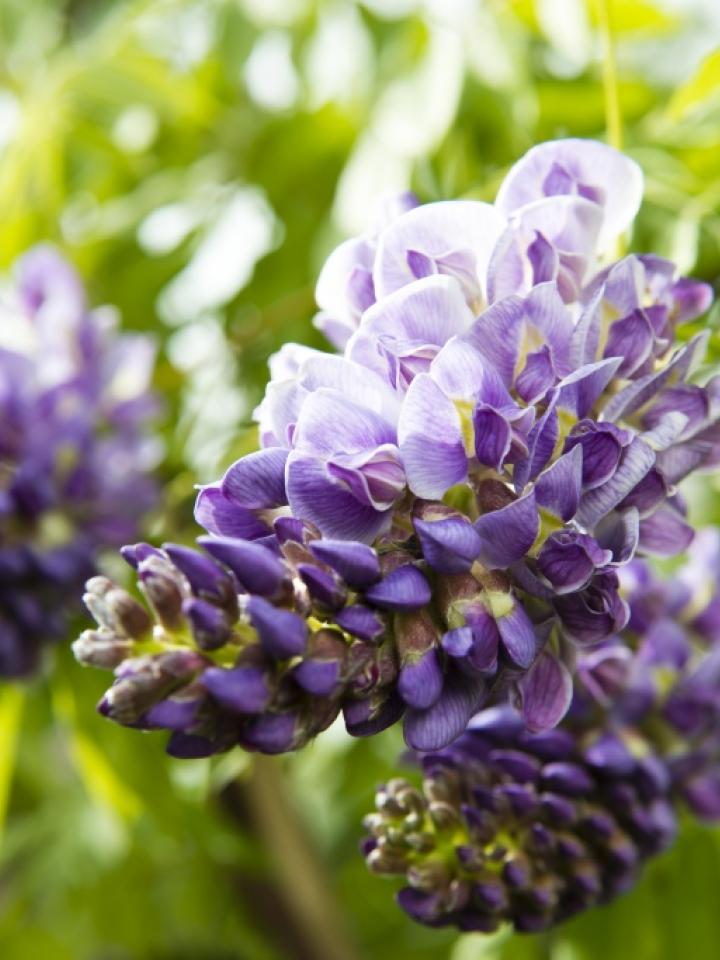
7) wisteria
Wisteria is a fast-growing climber characterised by romantic and colourful flower garlands. From lilac to blue and from white to pink, there are many types and colours which treat you to flowers that can reach up to 50cm in length. The plant can remain beautiful and continue to bloom for up to 50 years!
Note: Wisteria is a strong plant. The plant needs good, firm guidance as it grows, as the branches can become as thick as an arm! To prevent damage, don't place wisteria against anything delicate or fragile.
wisteria: where to plant it and care tips
Want wisteria to climb a wall, fence or other structure? Then check out the tips below for the planting location and caretaking tips for wisteria:
- Wisteria thrives best in a sunny location, where there is at least six hours of direct sunlight a day.
- Wisteria likes well-drained, moist soil that is not soggy.
- Wisteria grows very quickly, so give this climbing plant plenty of space.
- Water wisteria regularly during dry, hot periods.
- If necessary, apply a layer of mulch (organic material such as compost) around the plant to improve moisture retention and suppress weed growth.
PRUNING WISTERIA
Wisteria grows very quickly, which is why it's essential to prune this climbing plant. Check out the following tips for pruning wisteria:
- Due to this plant's strong and vigorous growth, it's recommended to prune wisteria twice a year. If you don't prune, it will soon become a tangle of long, thin branches. Prune wisteria before flowering in early spring (February) and after flowering (in July or August).
- Wisteria flowers on old wood (flowers bloom on old branches and not on the branches that will grow that year). For this reason, it's important to never prune wisteria too rigorously.
- Prune wisteria in early spring:
- Timing is important! Make sure severe frosts are over and prune before the flower buds begin to grow large.
- Prune long, young shoots back about 10-15 centimetres from the main branches (or two-three buds).
- Leave the main branches alone as much as possible, unless they get too big.
- Remove any dead or damaged branches.
- Prune wisteria after flowering (summer pruning):
- Prune wisteria after the climbing plant has finished flowering. Do not prune during an extremely hot and dry period and or in full sun.
- Prune back long, young shoots to about 40-50 centimetres (or five-six buds) from the main branches.
- Leave the main branches alone as much as possible unless they get too big.
- Remove any dead or damaged branches.
More green inspiration
For more green inspiration for inside and out, check out our grey to green dossier. We'd love to see your green wall! Share it with us on Instagram or Facebook with the hashtags #thejoyofplants and #fromgreytogreen.




